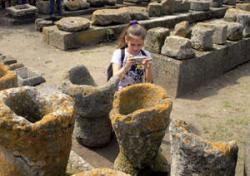Olbia is back in the spotlight
Olha Hlushchenko
Source - http://www.day.kiev.ua/223002
Archaeologists discovered unique ancient Greek graves dating back to the 4th century BC in the center of Mykolaiv
UKRINFORM photo

|
The local history museum is soon to be opened in Mykolaiv, to be located in the Old Navy Barracks historic building. The start of work on reconstruction of the building and renovation of the surrounding area enabled the archaeologists to make a unique discovery by finding an ancient necropolis dating back to the 4th century BC and belonging to the so-called Mykolaiv-6 settlement that was located in the area currently occupied by the 61 Communard Shipyard.
Archaeologist and deputy director of the Ukrainian Academy of Sciences’ Institute of Archaeology’s Bay of the Sea research center Oleksandr Smyrnov says that even the very existence of the cemetery in this place was little known to the researchers.
“This is a Hellenistic necropolis of mid-4th century BC. We have found 25 graves in total. They are all Greek burials, containing the remains of individuals from the epoch,” Smyrnov tells us. “Having studied these graves, we already know almost everything about them, from plan of necropolis to grave orientation and funeral rite that the Greeks observed at the time.”
Smyrnov also shared with us information about archaeological finds.
“All the graves contain items of burial inventory, that is, the items that accompanied the deceased to another world, into the realm of Hades, according to the religious beliefs of the ancient Greeks. These include, first of all, Athenian ceramic pots from Attica, antique black-figure pottery, wine kylixes of peculiar form, salt shakers covered with graffiti, and imported Heraclean amphorae with stamps of the 6th century BC. Almost all the male graves contain some weapons. It is easily explained by the fact that people of this culture lived in the northernmost settlement of the Olbian chora that belonged to the republic of Olbia. It was namely this settlement that controlled the ford across the Inhul River. Therefore, all the men there had to have good fighting skills. As for the female graves, they contain mostly bronze wrist bracelets and some very interesting necklaces. We have found the remains of a woman’s dress trimmed with beads and paste in one of the graves. Another find is a necklace of kauri shells [kauri is a marine mollusk living in the Indian Ocean. – Ed.]. This shows the extent of trade relations at the time. We may confidently say that the ancient inhabitants of Mykolaiv area traded with Heraclea Pontica and Athens.”
The study found that, unlike other Olbian chora necropolises of Mykolaiv, this one was never robbed in the 18th to 19th centuries.
“All the graves were never robbed in the modern times. It is very interesting, because all the other sites in Mykolaiv region were robbed in the 19th and 20th centuries alike. So-called ‘black archaeologists’ are robbing them nowadays. They have looted huge parts of the necropolises in the region, stolen from the graves and sold their loot on the black market to private collectors,” Smyrnov says. This is not the only problem. According to the scholar, “farming presents great problem for us in Ukraine in general and in Mykolaiv region in particular. For often it happens that the plot of land has no owner, or if there is an owner, he or she is ignorant of the law and so they plow up mounds, burial grounds, ancient settlements and forts even where there is a recognized archaeological site. Unfortunately, many farmers ignore this circumstance and just drive their tractors and plows there, destroying these sites.”
All artifacts found are now on display in closed shelves of Sukhomlynsky National University’s Institute of History and Law. They will be processed by the scholars and then turned over to the Mykolaiv Local History Museum that will place them in storerooms, put on an exhibition, or send to the restoration department. The total value of artifacts found in the necropolis is estimated at close to 50, 000 US dollars.